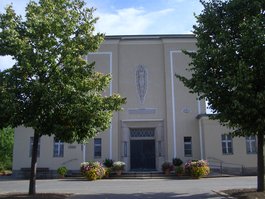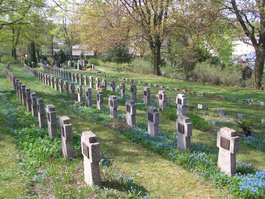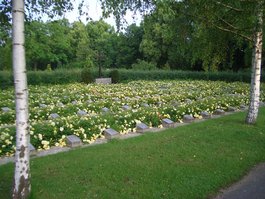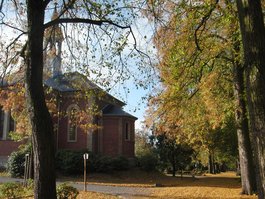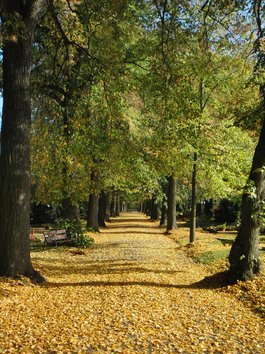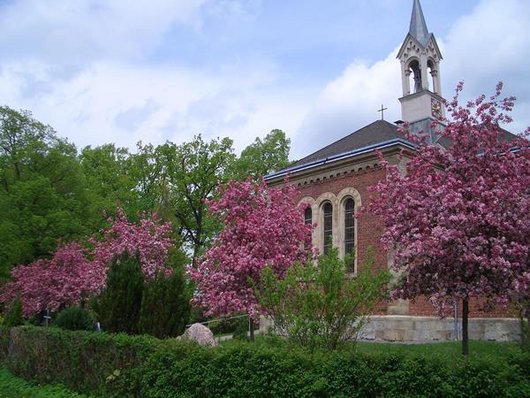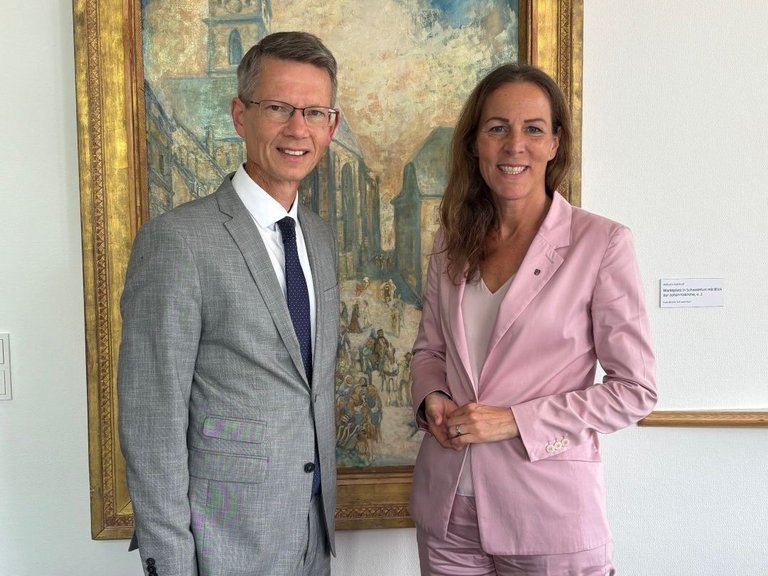Cemeteries
There are three cemeteries in the town of Hof: the listed main cemetery with crematorium on Plauener Straße, the small former village cemetery in Moschendorf and the Israelite cemetery run by the Jewish community. The cemetery administration will be happy to answer any general or specific questions you may have about the cemetery.
The cemetery as a monument
The Hof cemetery on Plauener Straße was designated as a monument in its entirety in 1973 due to the large number and complexity of historically and artistically valuable individual monuments, as well as the 19th century cemetery chapel and the crematorium from the 1920s.
Since then, individual grave monuments have also been placed under protection, which justify the value of the entire monument complex.
For the grave owner, this means no additional burden, the grave can continue to be used in the usual way, only the gravestones may not be removed or replaced. Updating the inscriptions, on the other hand, is expressly desired and permitted.
Graves of honor in the Hof cemetery
Grave field XIV: 123 war graves of the First World War
The site was given its current appearance in 1993, when the old, white-painted grave crosses were replaced by permanent bronze crosses. The special appearance of this burial ground is characterized by the enamelled name plaques on each of the crosses. The War Graves Commission played a key role in the redesign.
Burial ground XV: for fallen and deceased of the Second World War
Thanks to an extraordinary repair measure in 1997/1998, strongly supported by the German War Graves Commission, the old, rotten wooden crosses of the soldiers' graves were replaced by 110 shell limestone crosses. There is a bronze plaque on each grave cross containing the dates of those buried here. Among others, 23 unknown Russian and two unknown Hungarian soldiers rest in this cemetery.
Burial ground XII:
234 citizens of the city of Hof who lost their lives in the Allied bombing raids in February and April 1945 are buried on this burial ground. This field is also maintained and cared for by the city of Hof in perpetuity.
In total, the city of Hof maintains and cares for almost 1,000 graves scattered over various burial grounds where soldiers, bomb victims and displaced persons found their final resting place.
History
Traditionally, every church and many chapels had a cemetery. This was also the case in Hof, where people could be buried next to St. Lawrence in the Middle Ages. When St. Michael's Church was extended in 1480, the inhabitants of Hof's new town lost their burial place there and from then on were also buried next to St. Lawrence. The hospital and the two monasteries also had their own small cemeteries for their staff and inmates. There was also a cemetery at Sankt Erhard (on Schleizer Straße), where there was an "infirmary". Executed people and murderers were buried next to the gallows (today the street on Galgenleite). After the Reformation, all of Hof's cemeteries (except the one at the gallows) were abandoned in favor of Sankt Lorenz. The former cemeteries were built on over time.
The cemetery next to St. Lawrence's Church was extended several times (within the current enclosure walls). From the 18th century onwards, Hof's population grew rapidly. This resulted in the need for new cemeteries, which were built on the periphery of the built-up area. A branch of the Lorenzfriedhof cemetery on the other side of Lorenzgasse (roughly between Biengässchen and Pfarr) was created in 1759. In the middle of the 19th century, when the population "exploded", both cemeteries were overcrowded. The intervals between burials were shortened to just a few years and up to four coffins were placed on top of each other in one grave.
A remedy was found in 1863: A new facility on Sophienberg was inaugurated, but this was also occupied after a short time. From 1878 onwards, no one could be buried here. The former cemetery at the Lorenzkirche was redesigned as Lorenzpark in 1906. In 1910, the Sophienberg cemetery was turned into Wittelsbacher Park, a recreational area for the new station district, to commemorate the 100 years Hof had belonged to Bavaria. The area between Biengässchen and Pfarr was built over. Finally, in 1878, a permanent solution was found: the cemetery on Plauener Straße, which still fulfills its function today. Here, far from the town, a large area was available which could be extended as required. The site was crowned in 1928/29 with the construction of a prestigious crematorium.
The Catholic parish, which slowly developed in the town of Hof, which had been Lutheran since 1529, from 1810, built a church, school, rectory and other parish buildings, but did not have its own cemetery. No cemetery could be established at St. Mary's Church, which was built in the old town from 1864.
The situation was different for the Jewish community. It is not known where the Jews of Hof buried their dead in the Middle Ages - before the expulsion from Hof in 1515. When the Jewish community was re-established in the 19th century, the question arose as to where a permanent burial ground could be created where the dead could be laid to eternal rest. In 1911, a Jewish cemetery was opened on the Hohe Saas, on the road to Wölbattendorf, far from the town. Apart from the interruption during the National Socialist era, when the Jews were expelled from Hof and forcibly expropriated, this burial site is still used today.
Today's Hof suburbs, which were incorporated during the 20th century, had all been "parishes" of Hof since the Middle Ages, i.e. they did not have their own churches until the 20th century, but belonged to the parish(es) of Hof. As a result, no cemeteries were built in these villages. The only exception was Moschendorf, where the need for its own cemetery was announced when the village grew considerably after the Moschendorf porcelain factory was founded in 1878. After all, the walk to the cemetery on Plauener Straße took around 90 minutes. Moschendorf is also special because the cemetery was opened before the church. Shortly before the incorporation of Hof, Moschendorf had a small burial ground in 1902, near which the Church of the Resurrection was built more than a quarter of a century later.
Dr. Arnd Kluge, City Archivist Hof
Types of graves
Types of graves available at the municipal cemetery on Plauener Straße
- Row graves
- Plot graves with one or more (up to six) coffin spaces
- Family gravesites with 2, 4 or 6 coffin spaces
- Choice of urn gravesites in the form of urn sites, urn sites, urn wall niches, stele niches and wall niches in the crematorium building
- Urn graves in the new urn grove
- Urn communal facility
Types of graves available at the municipal cemetery in Moschendorf
- Row graves
- Plot graves with one or more coffin spaces
- Urn graves
- Communal urn site
What to do in the event of death?
- Call the doctor! He will issue the death certificate. Have the identity card of the deceased ready.
- Notify other relatives who can help
- Notify the police if the cause of death is unclear
- Notify the funeral home and determine the scope of services
The following services are usually carried out by the mortician:
- Registry office: death certificate
- Cemetery administration: Determining the type and time of the funeral service and burial, extending an existing grave or making an appointment to select a grave, possibly making an appointment to lay the body to rest
- Appoint a priest or funeral orator
- Provide musical accompaniment
- Order obituary
- Reserve a restaurant
- Ordering coffin arrangements, wreaths and other items
- Notify pension fund, health insurance, insurance companies, banks, employer, apply for survivor's pension
